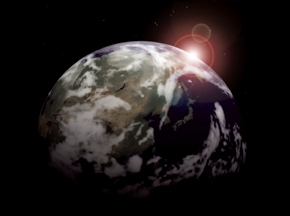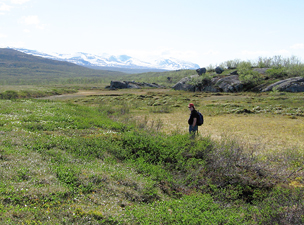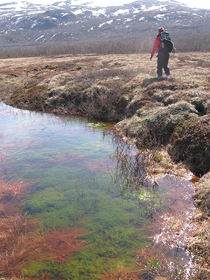Peat Soup
THEY COVER THREE TO FIVE PERCENT of the global land surface, contain about 20 percent of all terrestrial organic carbon, contribute a significant proportion of the biogenic emissions of methane (a greenhouse gas) to the atmosphere, and have been largely ignored in discussions on climate change/global warming.
They are peatlands – bogs, fens, swamps, and marshes that accumulate peat – a highly organic material composed of partially decayed plant matter.
But as the Arctic continues to dribble away and high-latitude peatlands, which are often associated with permafrost, transform under the fast-warming conditions, more attention is being paid to the potentially huge feedback system these northern lands represent.
To that end, in mid-May, 17 peatland ecologists and climate modelers from 10 institutes around the world gathered at EOS for a two-day workshop to discuss the challenges of getting peatlands into global carbon cycle models – in particular coupled carbon-climate models, which can directly simulate climate system feedbacks related to the carbon cycle, e.g., warming causing forest dieback causing carbon loss leading to more warming, etc.
Peatlands are one of a handful of the key elements targeted for inclusion in carbon-climate models, although they may not be incorporated in time for the 2014 Intergovernmental Panel on Climate Change (IPCC) Fifth Assessment Report since completed simulations are required two or more years prior to publication.
The UNH workshop, which was funded through the National Science Foundation’s Peatland Ecosystem Analysis and Training Network or PeatNet, was a prelude to The Second International Symposium on Carbon in Peatlands held in Prague, Czech Republic in late September. The symposium drew a large percentage of the peatland research community, which is relatively small compared to other terrestrial, ecological disciplines.
“It is a small research community, and that is perhaps one of the reasons peatlands have been neglected up till now,” says Steve Frolking of the Complex Systems Research Center and co-organizer of the May EOS meeting. Frolking also organized a session at the Prague gathering and made an oral presentation. In addition to Frolking, graduate students and Research and Discover fellows Claire Treat and Genevieve Noyce, both of whom have done peat-related research projects, presented posters in Prague.
PeatNet’s focus is on northern peatland ecosystems, including permafrost, but Frolking notes that their tropical counterparts, too, are an important and even less-studied part of the big peatlands picture. At the Prague meeting, one scientist noted that tropical peatlands in Southeast Asia are under so much stress due to human activity that she felt they would all be severely degraded within a matter of decades.
One noted calamity to tropical peatlands was the 1996 Mega Rice Project in the Indonesian section of Borneo. The goal was to turn two-and-one-half-million acres of “unproductive” and sparsely populated peat swamp forest into rice paddies. After logging and draining the vast area, the project eventually failed and the parched landscape went up in flames. According to Frolking, because so little is known about these ecosystems – for example how plants propagate – it is uncertain if recovery is possible in the wake of such widespread damage.
Frolking says an additional reason for the neglect (by the scientific community) of northern peatlands is that they are of minimal economic value compared to say, forests, rangelands, or croplands. “If you look at research dollars into ecosystem studies, peatlands are in the noise of everything else. Most peatlands are remote, people don’t live there, they’re perceived as bug-infested swamps, and they’re pretty sluggish systems – things don’t happen very fast, plants grow slowly, and decomposition rates are very low.”
All that said, because peatlands in northern climes – where the climate is warming more rapidly than anywhere else on the globe – are poised on precarious physical and chemical thresholds, they could very suddenly play a big role in additional climate change.
Think of pushing a book ever closer to the edge of a table. Inch after inch there’s no change until – wham! – gravity hauls the book to the floor. If permafrost warms from minus two degrees Celsius to minus one not much will happen, but raise it from minus one to plus one and total change occurs – ice thaws to liquid water, gases are liberated, biology speeds up, etc.
Explains Frolking, “But no one really knows, it could go either way. The systems could get wetter and therefore release more methane or drier and release less. They could thaw and have all the soil carbon potentially respire and thus become a big carbon dioxide source, or they could become more productive and forests could move in and become CO2 sinks. They could even shift from one of these responses to another over a couple of decades. We just don’t have the ability to predict it cause we don’t know enough about what the response will be.”
Happily, some answers could be forthcoming thanks to recent funding from NASA’s Terrestrial Ecology Program that will allow CSRC’s Changsheng Li and colleagues to focus on high-latitude carbon dynamics using their DeNitrification-DeComposition model. To apply the model to these regions, Li and his colleagues are faced by challenges from not only the soil freezing/thawing processes but also the feedback between climate change and hydrology in the high-latitude wetlands.
The DNDC model can precisely simulate greenhouse gas emissions, e.g., nitrous oxide, carbon dioxide, and methane, across a variety of terrestrial ecosystems, under any climatic condition, anywhere in the world. But until now the model had not been applied to high-latitude Arctic regions. By doing so, scientists hope to get a clearer idea of what is most important to include in global models to, as Frolking says, “at least get at the first order of affects and feedbacks” of these northern peatland systems.
Stay tuned as more answers come in; we’re talking about a carbon pool half the size of all the carbon dioxide currently in the atmosphere. -DS
They are peatlands – bogs, fens, swamps, and marshes that accumulate peat – a highly organic material composed of partially decayed plant matter.
| Peatlands in Stordalen Mire, Sweden. Photo courtesy of Nigel Roulet, McGill University. |
To that end, in mid-May, 17 peatland ecologists and climate modelers from 10 institutes around the world gathered at EOS for a two-day workshop to discuss the challenges of getting peatlands into global carbon cycle models – in particular coupled carbon-climate models, which can directly simulate climate system feedbacks related to the carbon cycle, e.g., warming causing forest dieback causing carbon loss leading to more warming, etc.
Peatlands are one of a handful of the key elements targeted for inclusion in carbon-climate models, although they may not be incorporated in time for the 2014 Intergovernmental Panel on Climate Change (IPCC) Fifth Assessment Report since completed simulations are required two or more years prior to publication.
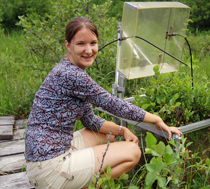 |
|
| Gennie Noyce Photo by K.Donahue, UNH-EOS. |
|
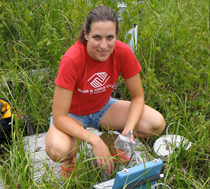 |
|
| Claire Treat Photo by K.Donahue, UNH-EOS. |
“It is a small research community, and that is perhaps one of the reasons peatlands have been neglected up till now,” says Steve Frolking of the Complex Systems Research Center and co-organizer of the May EOS meeting. Frolking also organized a session at the Prague gathering and made an oral presentation. In addition to Frolking, graduate students and Research and Discover fellows Claire Treat and Genevieve Noyce, both of whom have done peat-related research projects, presented posters in Prague.
PeatNet’s focus is on northern peatland ecosystems, including permafrost, but Frolking notes that their tropical counterparts, too, are an important and even less-studied part of the big peatlands picture. At the Prague meeting, one scientist noted that tropical peatlands in Southeast Asia are under so much stress due to human activity that she felt they would all be severely degraded within a matter of decades.
| Peatlands in Stordalen Mire, Sweden. Photo courtesy of Nigel Roulet, McGill University. |
Frolking says an additional reason for the neglect (by the scientific community) of northern peatlands is that they are of minimal economic value compared to say, forests, rangelands, or croplands. “If you look at research dollars into ecosystem studies, peatlands are in the noise of everything else. Most peatlands are remote, people don’t live there, they’re perceived as bug-infested swamps, and they’re pretty sluggish systems – things don’t happen very fast, plants grow slowly, and decomposition rates are very low.”
All that said, because peatlands in northern climes – where the climate is warming more rapidly than anywhere else on the globe – are poised on precarious physical and chemical thresholds, they could very suddenly play a big role in additional climate change.
Think of pushing a book ever closer to the edge of a table. Inch after inch there’s no change until – wham! – gravity hauls the book to the floor. If permafrost warms from minus two degrees Celsius to minus one not much will happen, but raise it from minus one to plus one and total change occurs – ice thaws to liquid water, gases are liberated, biology speeds up, etc.
Explains Frolking, “But no one really knows, it could go either way. The systems could get wetter and therefore release more methane or drier and release less. They could thaw and have all the soil carbon potentially respire and thus become a big carbon dioxide source, or they could become more productive and forests could move in and become CO2 sinks. They could even shift from one of these responses to another over a couple of decades. We just don’t have the ability to predict it cause we don’t know enough about what the response will be.”
Happily, some answers could be forthcoming thanks to recent funding from NASA’s Terrestrial Ecology Program that will allow CSRC’s Changsheng Li and colleagues to focus on high-latitude carbon dynamics using their DeNitrification-DeComposition model. To apply the model to these regions, Li and his colleagues are faced by challenges from not only the soil freezing/thawing processes but also the feedback between climate change and hydrology in the high-latitude wetlands.
The DNDC model can precisely simulate greenhouse gas emissions, e.g., nitrous oxide, carbon dioxide, and methane, across a variety of terrestrial ecosystems, under any climatic condition, anywhere in the world. But until now the model had not been applied to high-latitude Arctic regions. By doing so, scientists hope to get a clearer idea of what is most important to include in global models to, as Frolking says, “at least get at the first order of affects and feedbacks” of these northern peatland systems.
Stay tuned as more answers come in; we’re talking about a carbon pool half the size of all the carbon dioxide currently in the atmosphere. -DS
by David Sims, Science Writer, Institute for the Study of Earth, Oceans, and Space. Published in Fall 2009 issue of EOS .
